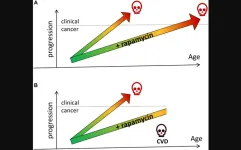(Press-News.org) COLUMBUS, Ohio – Gynecologic surgeons with The Ohio State University Comprehensive Cancer Center – Arthur G. James Cancer Hospital and Richard J. Solove Research Institute (OSUCCC – James) are leading an international clinical trial to determine whether minimally invasive surgery robotic surgery is better or worse than open surgery when performing a radical hysterectomy to treat cervical cancer.
Although minimally invasive and robotic-assisted surgery techniques have become the standard approach for many surgeries, in gynecologic cancer open surgery – which involves one large incision versus several keyhole-sized incisions – has remained the standard practice for radical hysterectomy.
Radical hysterectomy is a procedure that involves removal of the uterus, cervix, parametria (tissue beside the cervix) and upper part of the vagina with lymphadenectomy, an additional procedure required for treatment of early-stage cervical cancer.
The preference for an open approach to radical hysterectomy is in direct response to a 2018 study published in the New England Journal of Medicine – known as the Laparoscopic Approach to Cervical Cancer (LACC) trial – which reported concerns over increased risk for cancer recurrence and death in women undergoing minimally invasive surgery for cervical cancer.
In this new international study sponsored by the Gynecologic Oncology Group, researchers hypothesize that minimally invasive, robotic-assisted radical hysterectomy is not inferior to open surgery when appropriate tumor containment methods are utilized and intrauterine manipulators are avoided. If proven, this would refute the LACC trial that led to a dramatic shift away from minimally invasive surgery.
Kristen Bixel, MD, a gynecologic oncologist with the OSUCCC – James, strongly believes that minimally invasive surgery should be re-evaluated as an option for patients with early-stage cervical cancer. She notes having this surgery through a minimally invasive approach could be especially impactful for young women living with the long-term impact of treatment for cervical cancer.
“Studies have proven that robotic surgery results in less pain, fewer deaths and fewer surgical complications. We have greater knowledge now of how to reduce risk of recurrence through standardized tumor containment techniques, introduction of preoperative imaging and other standardized methodologies. Women deserve a better option than open surgery,” said Bixel, who serves as one of four international co-principal investigators along with colleague Allison Quick, MD.
“Criticisms of the LACC trial include lack of uniform preoperative imaging and assessment, use of transcervical uterine manipulators and lack of proper tumor containment, leading to peritoneal contamination. Subsequent retrospective studies have reported conflicting results,” said Bixel. “Our study addresses all the limitations of the LACC trial.”
For this study, gynecologic oncologists at more than 80 centers across the United States and Canada will enroll up to 840 patients. Patients will be randomized to have a radical hysterectomy via standard open technique or to a study arm in which they will receive a radical hysterectomy via standard robotic technique, but with new protective maneuvers around proper tumor containment and preoperative imaging and assessment.
A Data Safety Monitoring Committee will conduct periodic reviews of safety, including two planned formal interim analyses for harm after accrual of 370 and 640 patients. Patients will be followed for three years to monitor for cancer recurrence.
“Results of this trial could potentially alter the surgical approach to treatment of early-stage cervical cancer,” said Bixel. “With strict patient-selection criteria and protective surgical maneuvers to prevent tumor exposure to the peritoneal cavity at the time of minimally invasive radical hysterectomy, we may be able to optimize oncologic outcomes, reduce complications and improve perioperative recovery in women with early-stage cervical cancer.”
To learn more about participating in clinical research at the OSUCCC – James, visit cancer.osu.edu/clinicaltrials or call 1-800-293-5066. Information about this specific study can be found here.
-30-
END
International clinical trial conducts head-to-head comparison of open versus minimally invasive surgery for early-stage cervical cancer
Experts say study results could be ‘practice changing’ for treatment of cervical cancer
2023-04-17
ELSE PRESS RELEASES FROM THIS DATE:
nPOD honors Estefania Quesada Masachs for type 1 diabetes discoveries
2023-04-17
LA JOLLA, CA—La Jolla Institute for Immunology (LJI) Instructor Estefania Quesada Masachs, M.D., Ph.D., has won the 2023 Young Investigator of the Year Award from the Network for Pancreatic Organ donors with Diabetes (nPOD). This prestigious award recognizes Quesada Masachs' groundbreaking research in type 1 diabetes.
Quesada Masachs says she was "happily surprised" to receive the award from nPOD at their 2023 conference. The organization provides pancreatic tissue samples to researchers, opening the door for in-depth research into type 1 diabetes, an autoimmune disease where the body's own immune ...
Cancer prevention with rapamycin
2023-04-17
“[...] long-term treatment with rapamycin slows down aging, a major risk factor for cancer [...]”
BUFFALO, NY- April 17, 2023 – A new research perspective was published in Oncotarget's Volume 14 on April 14, 2023, entitled, “Cancer prevention with rapamycin.”
The mTOR (Target of Rapamycin) pathway is involved in both cancer and aging. Furthermore, common cancers are age-related diseases, and their incidence increases exponentially with age. In his new research perspective, Mikhail V. Blagosklonny, M.D., Ph.D., from Roswell Park Comprehensive Cancer Center discusses rapamycin and other rapalogs and their ...
Temperature, drought influencing movement of Plains bison
2023-04-17
It epitomizes the Great Plains in spirit and in form: a 2,000-pound tank on hooves, cloaked in shaggy winter-tested coat, capped by horns acting as warning and weapon.
Even its scientific name, Bison bison bison, seems to conjure an echo worthy of its majesty. Still, the implacable profile of the Plains bison — the national mammal of the United States and largest on the continent — belies the vulnerability in its history, which saw its legions decimated from tens of millions to just a few hundred in the span of a few colonial centuries.
Conservation efforts have pushed its number back to roughly 20,000, and its status from endangered ...
Oregon State researchers make breakthrough in understanding the chemistry of wildfire smoke in wine
2023-04-17
CORVALLIS, Ore. – Oregon State University researchers have discovered a new class of compounds that contributes to the ashy or smokey flavors in wine made with grapes exposed to wildfire smoke.
This development is significant for winemakers who have struggled to combat the impact of smoke on grapes at a time when climate change is leading to an increase in the number and severity of wildfires, the researchers said.
“These findings provide new avenues for research to understand and prevent smoke taint in grapes,” said Elizabeth Tomasino, an associate professor of enology ...
Coastal species persist on high seas on floating plastic debris
2023-04-17
The high seas have been colonized by a surprising number of coastal marine invertebrate species, which can now survive and reproduce in the open ocean, contributing strongly to the floating community composition. This finding was published today in Nature Ecology and Evolution by a team of researchers led by the Smithsonian Environmental Research Center (SERC) and the University of Hawai‘i (UH) at Mānoa.
The researchers found coastal species, representing diverse taxonomic groups and life history traits, in the eastern North Pacific Subtropical Gyre on over 70 percent of the plastic debris ...
UCF researchers create digital map of sympathetic nervous system
2023-04-17
UCF Researchers Create Digital Map of Sympathetic Nervous System
A team of UCF College of Medicine researchers has created a digital topographical map of the cardiac sympathetic neural network, the region that controls the body’s heart rate and its “fight-or-flight” response. They hope this map will eventually serve as a guide to treat cardiovascular conditions using bioelectronic devices.
The study, led by Dr. Zixi Jack Cheng, a neuro-cardiovascular scientist, was published in the Scientific Reports journal ...
UCF scientist publishes book on emergence of new pathogens
2023-04-17
Climate change may be linked to an increase in the emergence of new pandemics, according to a new book published by an internationally recognized College of Medicine microbiologist.
Dr. Salvador Almagro-Moreno has teamed with fellow molecular biologist Dr. Stefan Pukatzki of City University New York – CUNY, to author the book titled Vibro spp. Infections, recently published by Springer Nature and includes the latest scientific research articles in this field from experts worldwide.
The book examines the factors associated with ...
Prime editing shows proof of concept for treating sickle cell disease
2023-04-17
(MEMPHIS, Tenn. – April 17, 2023) Sickle cell disease (SCD) is a serious blood disorder affecting millions of people, primarily those of African descent. A mutation in the gene that encodes a subunit of the oxygen-carrying molecule, hemoglobin, causes the disease. Scientists at St. Jude Children’s Research Hospital and the Broad Institute of MIT and Harvard showed a precise genome editing approach, prime editing, can change mutated hemoglobin genes back to their normal form in SCD patient cells, which restores ...
JNM publishes appropriate use criteria for lymphoscintigraphy in sentinel node mapping and lymphedema/lipedema
2023-04-17
Reston, VA—The Society of Nuclear Medicine and Molecular Imaging (SNMMI) and 10 other professional societies have issued new appropriate use criteria (AUC) for lymphoscintigraphy in sentinel node mapping and lymphedema/lipedema. The criteria, summarized in the April issue of The Journal of Nuclear Medicine (JNM), include a list of relevant clinical scenarios, a systematic review of evidence in the literature, and a systematic analysis of available evidence, followed by grading each of the clinical scenarios.
Sentinel lymph nodes ...
Father of the photonic bandgap to speak at Utah State University
2023-04-17
Renowned physicist, engineer and entrepreneur Eli Yablonovitch will visit Utah State University on April 25 for two lectures about his work in the electrical and computer engineering field.
Yablonovitch, who is currently a professor emeritus at the University of California Berkeley, will present lectures on controlling carbon intake as a solution to climate change and on physics and optimization in the engineering world. The lectures will take place on April 25, at 1 pm and 3 pm respectively. An RSVP form can be found on this webpage. All are encouraged to attend.
“Having Dr. Yablonovitch travel to speak to us is a great honor and a great opportunity for us ...
LAST 30 PRESS RELEASES:
Sleeping in on weekends may help boost teens’ mental health
Study: Teens use cellphones for an hour a day at school
After more than two years of war, Palestinian children are hungry, denied education and “like the living dead”
The untold story of life with Prader-Willi syndrome - according to the siblings who live it
How the parasite that ‘gave up sex’ found more hosts – and why its victory won’t last
When is it time to jump? The boiling frog problem of AI use in physics education
Twitter data reveals partisan divide in understanding why pollen season's getting worse
AI is quick but risky for updating old software
Revolutionizing biosecurity: new multi-omics framework to transform invasive species management
From ancient herb to modern medicine: new review unveils the multi-targeted healing potential of Borago officinalis
Building a global scientific community: Biological Diversity Journal announces dual recruitment of Editorial Board and Youth Editorial Board members
Microbes that break down antibiotics help protect ecosystems under drug pollution
Smart biochar that remembers pollutants offers a new way to clean water and recycle biomass
Rice genes matter more than domestication in shaping plant microbiomes
Ticking time bomb: Some farmers report as many as 70 tick encounters over a 6-month period
Turning garden and crop waste into plastics
Scientists discover ‘platypus galaxies’ in the early universe
Seeing thyroid cancer in a new light: when AI meets label-free imaging in the operating room
Neutrophil-to-lymphocyte ratio may aid risk stratification in depressive disorder
2026 Seismological Society of America Annual Meeting
AI-powered ECG analysis offers promising path for early detection of chronic obstructive pulmonary disease, says Mount Sinai researchers
GIMM uncovers flaws in lab-grown heart cells and paves the way for improved treatments
Cracking the evolutionary code of sleep
Medications could help the aging brain cope with surgery, memory impairment
Back pain linked to worse sleep years later in men over 65, according to study
CDC urges ‘shared decision-making’ on some childhood vaccines; many unclear about what that means
New research finds that an ‘equal treatment’ approach to economic opportunity advertising can backfire
Researchers create shape-shifting, self-navigating microparticles
Science army mobilizes to map US soil microbiome
Researchers develop new tools to turn grain crops into biosensors
[Press-News.org] International clinical trial conducts head-to-head comparison of open versus minimally invasive surgery for early-stage cervical cancerExperts say study results could be ‘practice changing’ for treatment of cervical cancer







